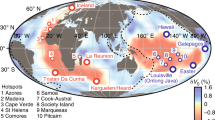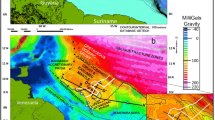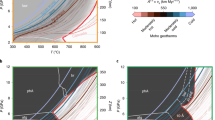Abstract
The Earth's convecting upper mantle can be viewed as comprising three main reservoirs, beneath the Pacific, Atlantic and Indian oceans. Because of the uneven global distribution and migration of ridges and subduction zones, the surface area of the Pacific reservoir is at present contracting at about 0.6 km2 yr-1, while the Atlantic and Indian reservoirs are growing at about 0.45 km2 yr-1 and 0.15 km2 yr-1, respectively1,2. Garfunkel1 and others have argued that there must accordingly be net mantle flow from the Pacific to the Atlantic and Indian reservoirs (in order to maintain mass balance), and Alvarez2 further predicted that this flow should be restricted to the few parts of the Pacific rim (here termed ‘gateways’) where there are no continental roots or subduction zones that might act as barriers to shallow mantle flow. The main Pacific gateways are, according to Alvarez2,3, the southeast Indian Ocean, the Caribbean Sea and the Drake passage. Here we report geochemical data which confirm that there has been some outflow of Pacific mantle into the Drake passage—but probably in response to regional tectonic constraints, rather than global mass-balance requirements. We also show that a mantle domain boundary, equivalent to the Australian–Antarctic discordance, must lie between the Drake passage and the east Scotia Sea.
This is a preview of subscription content, access via your institution
Access options
Subscribe to this journal
Receive 51 print issues and online access
$199.00 per year
only $3.90 per issue
Buy this article
- Purchase on Springer Link
- Instant access to full article PDF
Prices may be subject to local taxes which are calculated during checkout



Similar content being viewed by others
References
Garfunkel, Z. Growth, shrinking, and long-term evolution of plates and their implications for the flow pattern in the mantle. J. Geophys. Res. 80, 4425–4432 (1975).
Alvarez, W. Geological evidence for the geographical pattern of mantle return flow and the driving mechanism of plate tectonics. J. Geophys. Res. 87, 6697–6710 (1982).
Alvarez, W. Geologic evidence for the plate driving mechanism: the continental undertow hypothesis and the Australian-Antarctic Discordance. Tectonics 5, 1213–1229 (1990).
Barker, P. F. & Burrell, J. The opening of Drake Passage. Mar. Geol. 25, 15–34 (1977).
Barker, P. F. in Backarc Basins: Tectonics and Magmatism (ed. Taylor, B.) 281–314 (Plenum, New York, 1995).
Saunders, A. D., Tarney, J., Weaver, S. D. & Barker, P. F. in Antarctic Geoscience (ed. Craddock, C.) 213–222 (Univ. Wisconsin Press, Madison, 1982).
Klein, E. M., Langmuir, C. H., Zindler, A., Staudigel, H. & Hamelin, R. Isotope evidence of a mantle convection boundary at the Australian–Antarctic Discordance. Nature 333, 623–629 (1988).
Pyle, D. G., Christie, D. M., Mahoney, J. J. & Duncan, R. A. Geochemistry and geochronology of ancient southeast Indian and southwest Pacific seafloor. J. Geophys. Res. 100, 22261–22282 (1995).
Christie, D. M., West, B. P., Pyle, D. G. & Hanan, B. B. Chaotic topography, mantle flow and mantle migration in the Australian-Antarctic discordance. Nature 394, 637–644 (1998).
Mahoney, J. J. et al. Isotope and trace-element characteristics of a super-fast spreading ridge – East Pacific Rise, 13-23°S. Earth Planet Sci. Lett. 121, 173–193 (1994).
Bach, W., Hegner, E., Erzinger, J. & Satir, M. Chemical and isotopic variations along the superfast spreading East Pacific Rise from 6 to 30°S. Contrib. Mineral. Petrol. 116, 365–380 (1994).
Castillo, P. R., Natland, J. H., Niu, Y. & Lonsdale, P. F. Sr, Nd and Pb isotopic variation along the Pacific-Antarctic risecrest, 53-57°S: implications for the composition and dynamics of the South Pacific upper mantle. Earth Planet Sci. Lett. 154, 109-125 (1998).
Vlastélic, I. et al. Large-scale chemical and thermal division of the Pacific mantle. Nature 399, 345–350 (1999).
Ferguson, E. M. & Klein, E. M. Fresh basalts from the Pacific-Antarctic Ridge extend the Pacific geochemical province. Nature 366, 330–333 (1993).
Klein, E. M. & Karsten, J. L. Ocean-ridge basalts with convergent-margin geochemical affinities from the Chile Ridge. Nature 374, 52–57 (1995).
Bach, W. et al. Unusually large Nb-Ta depletions in North Chile ridge basalts at 36°50′ to 38°56′: major element, trace element and isotopic data. Earth Planet. Sci. Lett. 142, 223–240 (1996).
le Roex, A. P. et al. Petrology and geochemistry of basalts from the American-Antarctic Ridge, Southern Ocean: implications for the westward influence of the Bouvet mantle plume. Contrib. Mineral. Petrol. 90, 367–380 (1985).
Mahoney, J. J., Le Roex, A. P., Peng, Z., Fisher, R. L. & Natland, J. H. Southwestern limits of Indian Ocean Ridge mantle and the origin of low 206Pb/204Pb mid-ocean ridge basalt: isotope systematics of the Central Southwest Indian Ridge (17°-50°E). J. Geophys. Res. 97, 19771–19790 (1992).
Kurz, M. D., Le Roex, A. & Dick, H. J. B. Isotope geochemistry of the oceanic mantle near the Bouvet triple junction. Geochim. Cosmochim. Acta 62, 841–852 (1998).
Douglass, J., Schilling, J.-G. & Fontignie, D. Plume-ridge interactions of the Discovery and Shona mantle plumes with the southern mid-Atlantic Ridge (40-55°S). J. Geophys. Res. 104, 2941–2962 (1999).
Russo, R. M. & Silver, P. G. Trench-parallel flow beneath the Nazca plate from seismic anisotropy. Science 263, 1105–1111 (1994).
Russo, R. M., Silver, P. G., Franke, M., Ambeh, W. B. & James, D. E. Shear-wave splitting in northeast Venezuala, Trinidad and the eastern Caribbean. Phys. Earth Planet. Inter. 95, 251–275 (1996).
Helffrich, G., Wiens, D., Barrientos, S. & Vera, E. Mantle flow around South America through the Drake Passage: teleseismic shear wave splitting results from the SEPA. J. Conf. Abs. 4, 844 (1999).
Phipps Morgan, J., Morgan, W. J., Zhang, Y.-S. & Smith, W. H. F. Observational hints for a plume-fed sub-oceanic asthenosphere and its role in mantle convection. J. Geophys. Res. 100, 12753–12767 (1995).
Dvorkin, J., Nur, A., Mavko, G. & Ben-Avraham, Z. Narrow subducting slabs and the origin of backarc basalts. Tectonophysics 227, 63–79 (1993).
Livermore, R., Cunningham, A., Vanneste, L. & Larter, R. Subduction influence on magma supply at the East Scotia Ridge. Earth Planet. Sci. Lett. 150, 261–275 (1997).
Sleep, N. H. Hotspots and mantle plumes: some phenomenology. J. Geophys. Res. 95, 6715–6736 (1990).
Phipps Morgan, J. & Morgan, W. J. Two-stage melting and the geochemical evolution of the mantle: a recipe for mantle plum-pudding. Earth Planet. Sci. Lett. 170, 215–239 (1999).
Leat, P. T., Livermore, R. A., Millar, I. L. & Pearce, J. A. Magma supply in back-arc spreading centre segment E2, East Scotia Ridge. J. Petrol. 41, 845–866 (2000).
Woodhouse, J. H. & Dziewonski, A. M. Mapping the upper mantle: three-dimensional modeling of Earth structure by inversion of seismic waveforms. J. Geophys. Res. 89, 5953–5986 (1984).
Acknowledgements
We thank C. Ottley for analytical assistance; A. Saunders for providing some of the Scotia Sea samples; J. Mahoney, J. Phipps Morgan, G. Helffrich, G. Milne and M. Bott for discussions; and D. Christie for comments on the manuscript. This work was supported by the NERC.
Author information
Authors and Affiliations
Corresponding author
Supplementary information
Rights and permissions
About this article
Cite this article
Pearce, J., Leat, P., Barker, P. et al. Geochemical tracing of Pacific-to-Atlantic upper-mantle flow through the Drake passage. Nature 410, 457–461 (2001). https://doi.org/10.1038/35068542
Received:
Accepted:
Issue Date:
DOI: https://doi.org/10.1038/35068542
This article is cited by
-
A subduction influence on ocean ridge basalts outside the Pacific subduction shield
Nature Communications (2021)
-
Mantle flow and deep electrical anisotropy in a main gateway: MT study in Tierra del Fuego
Scientific Reports (2019)
-
Controls on crustal accretion along the back-arc East Scotia Ridge: constraints from bathymetry and gravity data
Marine Geophysical Research (2013)
-
Magmatic evolution of the South Shetland Islands, Antarctica, and implications for continental crust formation
Contributions to Mineralogy and Petrology (2012)
-
Evolution and diversity of subduction zones controlled by slab width
Nature (2007)
Comments
By submitting a comment you agree to abide by our Terms and Community Guidelines. If you find something abusive or that does not comply with our terms or guidelines please flag it as inappropriate.



